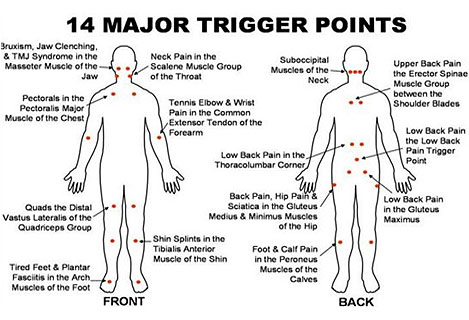There are over 640 muscles in the human body and besides enabling movement, they support posture and provide the force that enables blood circulation. Because muscles are often not given their due importance by many health professionals, they are known as the “Orphan Organs.”
What Are Myofascial Trigger Points?
A Myofascial Trigger Point is a muscle knot that becomes an area of hyperirritability that is sensitive to pressure and can cause a range of symptoms in various parts of the body. The knot or pressure point develops when the muscle fibres do not contract properly and are so unable to relax. In this stuck position, they become what is known as a “Taut Band.”
The Causes
- Among the causes are:
- Excessive muscle contraction for extended periods of time which reduce the blood supply to the muscle and cause the formation of trigger points.
- Injury, trauma or irritation that causes chemicals to be released which cause the muscle tissue to swell, which in turn causes the blood vessels to contract resulting in an inadequate supply of oxygen. This creates a trigger point.
- Pain, either real or perceived in muscles, joint or other organs of the body can cause the muscles to become tight and spasm resulting in trigger point formation.
- Prolonged periods of time during which the body is in an improper posture or position.
- Prolonged stretching of a muscle.
- Emotional issues like stress, anxiety, depression etc.
The Symptoms
- Among the various symptoms are:
- A dull aching pain at the trigger point.
- Pain when the affected area is touched or pressure is placed on it.
- Burning sensations.
- Headaches.
- Dizziness.
- Fatigue.
- Disturbed sleep.
The Pain Pattern
- The pain pattern can often mimic the symptoms of other medical conditions, even if imaging and other diagnostic tests show no abnormality. These symptoms include:
- Chest pain like that caused by Angina pectoris.
- Neck pain like that of Migraine or Vertigo.
- Abdominal pain similar to that of Appendicitis.
- Jaw and neck muscle pain like that caused by Tinnitus
- Ear Aches
- Sciatica-like pain in the buttock muscles.

The Treatment
The first step is to identify the trigger points that are causing the problem. The treatment for this condition consists of myofascial trigger release, dry needling, the use of muscle energy techniques, ultrasound, stretching, correction of the posture and strengthening exercises. Weakness may also result from this condition which will not be resolved until the trigger points are treated.
Who Provides Treatment?
Physiotherapists and Osteopaths are the health professionals who treat the Myofascial Trigger Points. A treatment plan based on the specific problems faced by the patient is devised to provide a cure and to improve muscle strength.
The Physiotherapists at Kauvery Hospital have the experience and expertise to deal most effectively with the problem and provide lasting relief.
Article by MP Kayalvezhi, MPT.,
Clinical Physiotherapist
Kauvery Hospital

